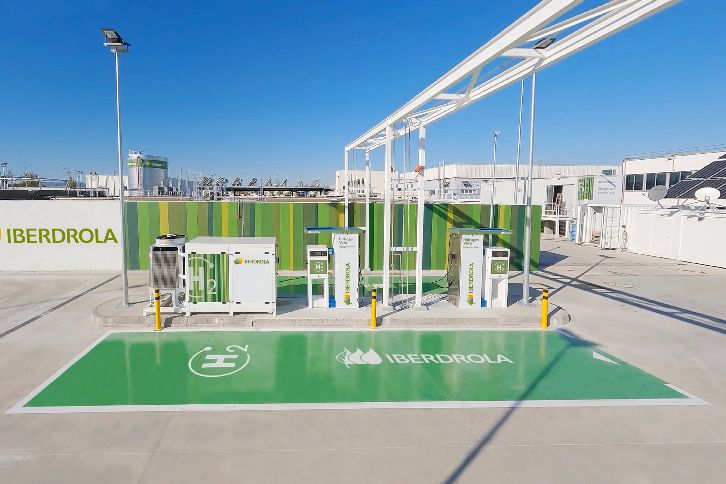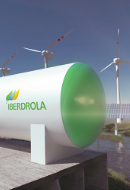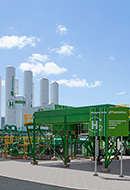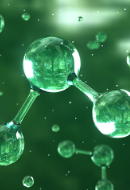Hydrogen stations
What are hydrogen stations and how do they work?
Sustainable mobility Green hydrogen
Green hydrogen is one of the great alternatives in terms of sustainable mobility, and for this hydrogen stations, or hydrogen pumps, which function as a refuelling station for this fuel, are necessary. The aim is for Spain to have a network of more than 100 hydrogen stations by 2030.

Green hydrogen, obtained by electrolysis from renewable electricity —which separates hydrogen from the oxygen present in water— is positioned as one of the most important alternatives to traditional energy resources and a key element in the drive towards decarbonisation of transport and sustainable mobility.
Hydrogen is the most common chemical element in nature and hydrogen-powered vehicles have been available for more than ten years, so the next step is to use hydrogen from renewable electricity, i.e. green hydrogen.
The main advantages of this type of vehicle are that they offer a greater level of autonomy and less dependence on the battery and, unlike traditional electric vehicles, refuelling times are similar to those of combustion vehicles. However, for this to become a reality, the network of hydrogen stations needs to be expanded.
How does a hydrogen station work?
The process of refuelling at a hydrogen station is not very different from that of a conventional petrol station, although there are some details that make the experience a little different. This is because hydrogen is supplied at high pressure and, as it is an extremely volatile gas, the connection between the vehicle's receptacle or connection point and the pump must be watertight.
The hydrogen is pumped into the vehicle's fuel tank, which powers the fuel cell that generates the electricity needed to drive the vehicle. The only waste product produced is water vapour, which is expelled through the exhaust pipe.
Unlike conventional filling stations, hydrogen is sold by the kilo, not by the litre, and the refuelling time for a conventional bus - which usually has a capacity of between 30 and 37.5 kilos - is no more than 12 minutes. And on the question of how much a hydrogen bus consumes, it is estimated at approximately 8 kilos per 100 kilometres, so the range of hydrogen vehicles currently on the market would be around 400 kilometres.
Hydrogen stations
The refuelling process in a hydrogen station is very similar to that of a conventional petrol station, although the hydrogen is supplied at high pressure.

Renewable energies
Green hydrogen is produced with renewable energy.
Water
The water used for electrolysis must contain salts and minerals to conduct electricity.

Electrolyser
It uses electric current to separate hydrogen from oxygen in water.
Compressor
It increases the pressure of hydrogen to store it.
Tanques
O hydrogen é armazenado em tanques de alta pressão – 500 bar.
Cooler
The supply requires that the hydrogen be refrigerated.
Dispenser
Depending on the size, it delivers between 60 and 120 g/s for vehicles from 200 kg/day up to 2,000 kg/day.
Buses typically have 5 tanks of 7.5 kg each at 350 bar, for a total of 37.5 kg of hydrogen.
 SEE INFOGRAPHIC: Hydrogen stations [PDF]
SEE INFOGRAPHIC: Hydrogen stations [PDF]
What is a hydrogen hub: definition and importance
A hydrogen hub is an integrated hydrogen ecosystem, designed to produce, store, distribute or transport hydrogen, considering the end use of hydrogen in various applications such as professional, distributed, and industrial power generation.
A hydrogen hub functions as a localized network, or “mini hydrogen economy” that streamlines the supply chain and reduces costs by consolidating hydrogen production and usage in one area.
The hydrogen hub is a specific solution addressed to individual enterprises, investments, or housing estates, to produce and use renewable hydrogen for their needs.

Green hydrogen
An alternative that reduces emissions and cares for our planet.

Difference between green and blue hydrogen
Discover the importance of the colours of hydrogen.

Green ammonia
The sustainable revolution in the chemical industry.

Green methanol and the maritime transport
This chemical compound is a promising alternative to fossil fuels.
Where is hydrogen found: locations and sources
Hydrogen is an essential element found in a wide range of substances on Earth, including water, plants, rocks, as well as humans and animals. Remarkably, hydrogen makes up approximately 75% of all matter in the universe.
It is present in diverse environments, from oceans and ice sheets to rivers, lakes, and even celestial bodies like the sun and moon. Additionally, hydrogen is a key component of the vast gas and dust clouds scattered across interstellar space.
Hydrogen is a significant component of the sun and moon, contribuiting to their composition and behavior. It plays a crucial role in the clouds of gas and dust.
Insights into the hydrogen spectrum
The hydrogen spectrum provides crucial evidence of quantized electronic structure of atoms. When an electric discharge is applied to gaseous hydrogen, the hydrogen atoms dissociate, leading to the emission of electromagnetic radiation from the excited atoms. This emission of electromagnetic radiation from the excited atoms.
This emission results in a spectrum of discrete frequencies known as the hydrogen emission spectrum. The different series of these spectral lines are named after the scientists who first identified them.








